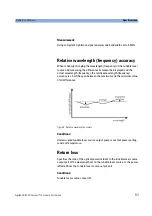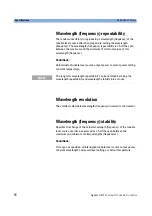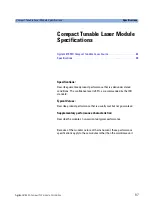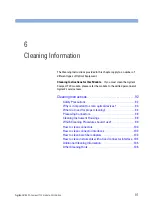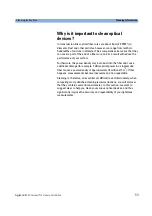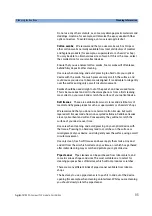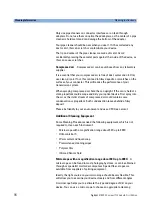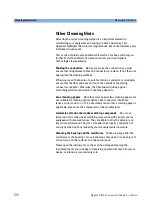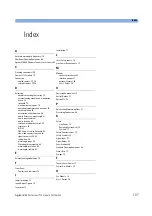
Cleaning Instructions
Cleaning Information
Agilent
81950A Compact TLS module, First Edition
97
method, and then to examine the results. You can also use your
microscope to judge whether your optical device (such as a connector) is
severely scratched and is, therefore, causing inaccurate measurements.
Ultrasonic bath
Ultrasonic baths are also available from photography or
laboratory suppliers or specialist mail order companies.
An ultrasonic bath will gently remove fat and other stubborn dirt from your
optical devices. This helps increase the life span of the optical devices.
Only use isopropyl alcohol in your ultrasonic bath, as other solvents may
damage.
Warm water and liquid soap
Only use water if you are sure that there
is no other way of cleaning your optical device without corrosion or
damage. Do not use hot water, as this may cause mechanical stress, which
can damage your optical device.
Ensure that your liquid soap has no abrasive properties or perfume in it.
You should also avoid normal washing-up liquid, as it can cover your device
in an iridescent film after it has been air-dried.
Some lenses and mirrors also have a special coating, which may be
sensitive to mechanical stress, or to fat and liquids. For this reason we
recommend you do not touch them.
If you are not sure how sensitive your device is to cleaning, please contact
the manufacturer or your sales distributor.
Premoistened cleaning wipes
Use pre-moistened cleaning wipes as
described in each individual cleaning procedure. Cleaning wipes may be
used in every instance where a moistened soft tissue or cotton swab is
applied.
Polymer film
Polymer film is available from laboratory suppliers or
specialist mail order companies.
Using polymer film is a gentle method of cleaning extremely sensitive
devices, such as reference reflectors and mirrors.
Infrared Sensor Card
Infrared sensor cards are available from
laboratory suppliers or specialist mail order companies.
With this card you are able to control the shape of laser light emitted. The
invisible laser beam is projected onto the sensor card, then becomes
visible to the normal eye as a round spot.
Take care never to look into the end of a fiber or any other optical
component, when they are in use. This is because the laser can seriously
damage your eyes.
Summary of Contents for 81950A
Page 1: ...Agilent Technologies Agilent 81950A Compact Tunable Laser Source module User s Guide ...
Page 9: ...Agilent 81950A Compact TLS module First Edition 9 ...
Page 10: ...10 Agilent 81950A Compact TLS module First Edition ...
Page 24: ...Getting Started Signal Input and Output 24 Agilent 81950A Compact TLS module First Edition ...
Page 30: ...Accessories User s Guides 30 Agilent 81950A Compact TLS module First Edition ...
Page 50: ...Operating Instructions The User Interface 50 Agilent 81950A Compact TLS module First Edition ...

